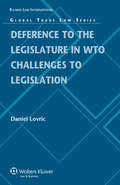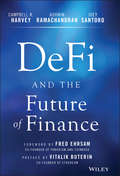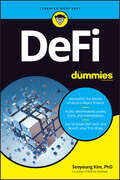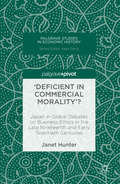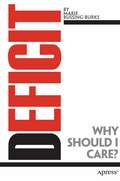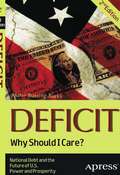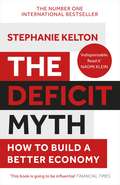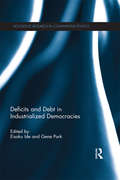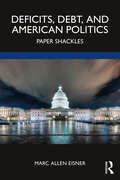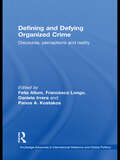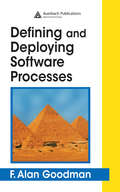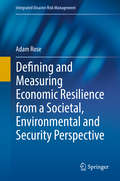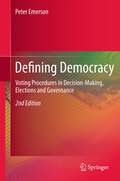- Table View
- List View
Deference in International Commercial Arbitration: The Shared System of Control in International Commercial Arbitration
In international arbitration, deference entails that one decision-maker does not make an autonomous assessment but limits its decision-making power out of respect for the decision or authority of another actor. For example, a court exercising post-award review might refrain from reviewing a question of procedure de novo but instead defer to a prior determination made by the arbitral tribunal. In this book, prominent arbitration practitioners and academics offer the first systematic analysis of such deference in international arbitration. With abundant reference to case law from major arbitration hubs, the analysis is organized around the three relationships in which questions of deference arise: public-private relationships in which a State actor (e.g., a court) must decide whether it should pay deference to determinations made by a private actor (e.g., a tribunal or an arbitral institution); public-public relationships in which a State actor (e.g., a court at the place of recognition and enforcement) must decide whether it should pay deference to another State actor (e.g., a court at the seat); and private-private relationships in which a private actor (e.g., an arbitral tribunal) must decide whether it should pay deference to another private actor (e.g., another arbitral tribunal or an arbitral institution). The book makes an important contribution to tracing the boundaries of the multiple layers of control over arbitration proceedings. It takes a giant step towards establishing the right equilibrium between the different layers of authority and thus meeting a pivotal challenge for the viability of arbitration as a form of dispute resolution.
Deference to the Legislature in WTO Challenges to Legislation
by Daniel LovricThis completely revised and up to date Fourth Edition of this well received work offers in one volume a comprehensive review of United States copyright, patent, and trademark laws. The material has been completely updated and includes detailed discussion of the 2011 America Invents Act, as well as other pertinent developments in U.S. law It provides thorough and sophisticated treatment of this complex material in a form both less cumbersome than a treatise and considerably deeper and more sophisticated than a study outline or "nutshell." With its detailed citations, and readily accessible and complete subject coverage, this book will be a useful quick reference or deskbook for intellectual property practitioners, students, law professors, and librarians, as well as for anyone interested in understanding American intellectual property law
DeFi and the Future of Finance
by Campbell R. Harvey Ashwin Ramachandran Joey SantoroDuring the Global Financial Crisis in 2008, our financial infrastructure failed. Governments bailed out the very institutions that let the economy down. This episode spurred a serious rethink of our financial system. Does it make any sense that it takes two days to settle a stock transaction? Why do retailers, operating on razor thin margins, have to pay 3% for every customer credit card swipe? Why does it take two days to transfer money from a bank account to a brokerage—or any other company? Why are savings rates miniscule or negative? Why is it so difficult for entrepreneurs to get financing at traditional banks? In DeFi and the Future of Finance, Campbell R. Harvey, Ashwin Ramachandran and Joey Santoro, introduce the new world of Decentralized Finance. The book argues that the current financial landscape is ripe for disruption and we are seeing, in real time, the reinvention of finance. The authors provide the reader with a clear assessment of the problems with the current financial system and how DeFi solves many of these problems. The essence of DeFi is that we interact with peers—there is no brick and mortar and all of the associated costs. Savings and lending are reinvented. Trading takes place with algorithms far removed from traditional brokerages. The book conducts a deep dive on some of the most innovative protocols such as Uniswap and Compound. Many of the companies featured in the book you might not have heard of—however, you will in the future. As with any new technology, there are a myriad of risks and the authors carefully catalogue these risks and assess which ones can be successfully mitigated. Ideally suited for people working in any part of the finance industry as well as financial policy makers, DeFi and the Future of Finance gives readers a vision of the future. The world of finance will fundamentally be changed over the coming decade. The book enables you to become part of the disruption – not the target of the disruption.
DeFi and the Future of Finance
by Campbell R. Harvey Ashwin Ramachandran Joey SantoroDuring the Global Financial Crisis in 2008, our financial infrastructure failed. Governments bailed out the very institutions that let the economy down. This episode spurred a serious rethink of our financial system. Does it make any sense that it takes two days to settle a stock transaction? Why do retailers, operating on razor thin margins, have to pay 3% for every customer credit card swipe? Why does it take two days to transfer money from a bank account to a brokerage—or any other company? Why are savings rates miniscule or negative? Why is it so difficult for entrepreneurs to get financing at traditional banks? In DeFi and the Future of Finance, Campbell R. Harvey, Ashwin Ramachandran and Joey Santoro, introduce the new world of Decentralized Finance. The book argues that the current financial landscape is ripe for disruption and we are seeing, in real time, the reinvention of finance. The authors provide the reader with a clear assessment of the problems with the current financial system and how DeFi solves many of these problems. The essence of DeFi is that we interact with peers—there is no brick and mortar and all of the associated costs. Savings and lending are reinvented. Trading takes place with algorithms far removed from traditional brokerages. The book conducts a deep dive on some of the most innovative protocols such as Uniswap and Compound. Many of the companies featured in the book you might not have heard of—however, you will in the future. As with any new technology, there are a myriad of risks and the authors carefully catalogue these risks and assess which ones can be successfully mitigated. Ideally suited for people working in any part of the finance industry as well as financial policy makers, DeFi and the Future of Finance gives readers a vision of the future. The world of finance will fundamentally be changed over the coming decade. The book enables you to become part of the disruption – not the target of the disruption.
DeFi For Dummies
by Seoyoung KimGet to know the building blocks of a new economy The promise of decentralized finance (DeFi for those up on their financial lingo) as a disruptor to financial institutions makes it must-know for anyone involved in finance. DeFi For Dummies provides an easy-to-understand option for unraveling the past, present, and future of DeFi. Understand current DeFi applications, including how to build basic applications on the leading platforms, and get a look into the future&’s most promising new DeFi solutions. Staying ahead of the game is critical for finance professionals these days, and this Dummies guide makes it possible, with full coverage of how DeFi affects asset management, lending and borrowing, and investment markets. Wrap your mind around DeFi and start getting hands on, the Dummies way. Learn how the DeFi revolution started and where it&’s going Get insight into opportunities for getting started and building value with DeFi Discover the leading assets, exchanges, and marketplaces built on DeFi principles Create secure DeFi applications on established platformsThis book is great for current pros or active investors in the world of finance who need to get up to speed on the world of DeFi as quickly and clearly as possible.
DeFi For Dummies
by Seoyoung KimGet to know the building blocks of a new economy The promise of decentralized finance (DeFi for those up on their financial lingo) as a disruptor to financial institutions makes it must-know for anyone involved in finance. DeFi For Dummies provides an easy-to-understand option for unraveling the past, present, and future of DeFi. Understand current DeFi applications, including how to build basic applications on the leading platforms, and get a look into the future&’s most promising new DeFi solutions. Staying ahead of the game is critical for finance professionals these days, and this Dummies guide makes it possible, with full coverage of how DeFi affects asset management, lending and borrowing, and investment markets. Wrap your mind around DeFi and start getting hands on, the Dummies way. Learn how the DeFi revolution started and where it&’s going Get insight into opportunities for getting started and building value with DeFi Discover the leading assets, exchanges, and marketplaces built on DeFi principles Create secure DeFi applications on established platformsThis book is great for current pros or active investors in the world of finance who need to get up to speed on the world of DeFi as quickly and clearly as possible.
'Deficient in Commercial Morality'?: Japan in Global Debates on Business Ethics in the Late Nineteenth and Early Twentieth Centuries (Palgrave Studies in Economic History)
by Janet HunterThis enlightening text analyses the origins of Western complaints, prevalent in the late nineteenth century, that Japan was characterised at the time by exceptionally low standards of 'commercial morality', despite a major political and economic transformation. As Britain industrialised during the nineteenth century the issue of 'commercial morality' was increasingly debated. Concerns about standards of business ethics extended to other industrialising economies, such as the United States. Hunter examines the Japanese response to the charges levelled against Japan in this context, arguing that this was shaped by a pragmatic recognition that Japan had little choice but to adapt itself to Western expectations if it was to establish its position in the global economy. The controversy and criticisms, which were at least in part stimulated by fear of Japanese competition, are important in the history of thinking on business ethics, and are of relevance for today's industrialising economies as they attempt to establish themselves in international markets.
Deficit: Why Should I Care?
by Marie Bussing-BurksAt the turn of this century, the American national debt stood at just under $6 trillion and the deficit at a "mere" $86 billion. Today, the national debt has topped $14 trillion, and the yearly deficit for 2011 is projected at a whopping $1.4 trillion. According to the U.S. Treasury Department's Annual Report on the Public Debt, the debt is estimated to hit $19.6 trillion by 2015. The federal government has borrowed roughly 40 percent of its total budget for the last several years, a disturbing trend that could leave the U.S. in an economic crisis. Astronomical interest payments, a debt burden to your children and grandchildren, and an increased reliance on foreign creditors are just a few of the problems. Although the U.S. has experienced soaring unemployment, stagnant production, and a crippled housing market, foremost on economists' minds are rising deficits and ballooning debt. Others feel fears of the national debt are overblown or pale in comparison to today's economic problems. This clear, concise book will give you the need-to-know on the debt. You will learn: How to calculate deficits and the national debt The history of U.S debt and its recent unparalleled growth over the years How and why the government borrows money Methods and tactics for balancing the budget The economic arguments for, and against, accruing a debt The impact of the debt on interest rates and inflation The impact of the debt on the value of the dollar and U.S. economic power This book also answers key questions: Can the government go bankrupt? Why have there seemingly been no repurcussions of the large debt to date and is that likely to change? When the interest on the debt becomes higher than the revenue of the government, what happens? And many more practical insights into the government debt controversy. Business professionals, parents, retirees, and students are all talking about the debt. This quick read will provide an understanding of the ramifications of the rising debt and what the consequences may be.
Deficit: Why Should I Care?
by Marie Bussing-BurksAt the turn of this century, the American national debt stood at just under $6 trillion and the deficit at a "mere" $86 billion. Today, the national debt has topped $15 trillion, and the yearly deficit for 2012 is projected at a whopping $1.2 trillion. This new, second edition of Deficits: Why Should I Care? updates all the statistics, charts, and forecasts, while adding a new chapter on how global economies now, for better or worse, affect the U.S. debt and the annual budget deficit. It also includes a new appendix detailing how the U.S. political parties view the debt issue. According to the U.S. Treasury Department’s Annual Report on the Public Debt, the debt is estimated to hit $19.6 trillion by 2015. The federal government has borrowed roughly 40 percent of its total budget for the last several years, a trend that could leave the U.S. in an economic crisis. Astronomical interest payments, a debt burden to your children and grandchildren, and an increased reliance on foreign creditors are just a few of the problems. Although the U.S. has experienced soaring unemployment, stagnant production, and a crippled housing market, foremost on many economists' minds are rising deficits and ballooning debt. Others feel fears of the national debt are overblown or pale in comparison to today’s economic problems. This clear, concise book will give you the need-to-know on the debt. You will learn: How to calculate deficits and the national debt The history of U.S debt and its recent unparalleled growth over the years How and why the government borrows money The economic arguments for, and against, accruing a debt Could we become like Greece if we don't cut our deficit? The impact of the debt on interest rates and inflation The impact of the debt on the value of the dollar and U.S. economic power This book also answers key questions: Can the government go bankrupt? Why have there seemingly been no repurcussions of the large debt to date and is that likely to change? When the interest on the debt becomes higher than the revenue of the government, what happens? And many more practical insights into the government debt controversy. Business professionals, parents, retirees, and students are all concerned about the debt. This quick read will provide an understanding of the ramifications of the rising debt and what the consequences may be.
The Deficit Myth: Modern Monetary Theory and How to Build a Better Economy
by Stephanie Kelton'Game-changing ... Read it!' - Mariana Mazzucato'In a world of epic, overlapping crises, Stephanie Kelton is an indispensable source of moral clarity ... the truths that she teaches about money, debt, and deficits give us the tools we desperately need to build a safe future for all. Read it - then put it to use.' - Naomi Klein The leading thinker and most visible public advocate of modern monetary theory - the freshest and most important idea about economics in decades - delivers a radically different, bold, new understanding for how to build a just and prosperous society.Any ambitious proposal - ranging from fixing crumbling infrastructure to Medicare for all or preventing the coming climate apocalypse - inevitably sparks questions: how can we afford it? How can we pay for it? Stephanie Kelton points out how misguided those questions really are by using the bold ideas of modern monetary theory (MMT), a fundamentally different approach to using our resources to maximize our potential as a society.We've been thinking about government spending in the wrong ways, Kelton argues, on both sides of the political aisle. Everything that both liberal/progressives and conservatives believe about deficits and the role of money and government spending in the economy is wrong, especially the fear that deficits will endanger long-term prosperity.Through illuminating insights about government debt, deficits, inflation, taxes, the financial system, and financial constraints on the federal budget, Kelton dramatically changes our understanding of how to best deal with important issues ranging from poverty and inequality to creating jobs and building infrastructure. Rather than asking the self-defeating question of how to pay for the crucial improvements our society needs, Kelton guides us to ask: which deficits actually matter? What is the best way to balance the risk of inflation against the benefits of a society that is more broadly prosperous, safer, cleaner, and secure?With its important new ways of understanding money, taxes, and the critical role of deficit spending, MMT busts myths that prevent us from taking action because we can't get beyond the question of how to pay for it. 'The best book on rethinking economics that anyone will find right now.' - Richard Murphy, Political Economist and author of The Joy of Tax 'A remarkable book both in content and timing. A 'must read' that is sure to influence many aspects of policymaking going forward' - Mohamed El-Erian, chief economic advisor at Allianz
Deficit Politics in the United States: Taxes, Spending and Fiscal Disconnect (Europa Economic Perspectives)
by Dennis S IppolitoFrom the clashes between Federalists and Republicans in the 1790s until today, partisan battles over taxing, spending, and public debt have shaped American political development. These battles were formerly constrained by fiscal norms that mandated balanced budgets and low debt. In his Farewell Address, President George Washington counseled the nation to "cherish public credit" by using "it as sparingly as possible". In the 1980s, however, tax cuts and spending increases created large structural deficits and much higher debt levels. With only a brief interruption in the late 1990s, deficit politics has been a mainstay ever since. Over this period, the Republican Party has passed large tax cuts but failed to retrench the large entitlement programs that continue to raise spending. Likewise, the Democratic Party has expanded the domestic role of government but has abandoned the broad-based taxation it supported in the 1990s. Funding their domestic agenda with matching revenues is now as unappealing for Democrats as entitlement cutbacks are for Republicans, contributing to the current stalemate of Republican tax policy, Democratic spending policy, and soaring deficits and debt. The economic risks this entails are serious, yet an end to the era of deficit politics is nowhere in sight.
Deficit Politics in the United States: Taxes, Spending and Fiscal Disconnect (Europa Economic Perspectives)
by Dennis S IppolitoFrom the clashes between Federalists and Republicans in the 1790s until today, partisan battles over taxing, spending, and public debt have shaped American political development. These battles were formerly constrained by fiscal norms that mandated balanced budgets and low debt. In his Farewell Address, President George Washington counseled the nation to "cherish public credit" by using "it as sparingly as possible". In the 1980s, however, tax cuts and spending increases created large structural deficits and much higher debt levels. With only a brief interruption in the late 1990s, deficit politics has been a mainstay ever since. Over this period, the Republican Party has passed large tax cuts but failed to retrench the large entitlement programs that continue to raise spending. Likewise, the Democratic Party has expanded the domestic role of government but has abandoned the broad-based taxation it supported in the 1990s. Funding their domestic agenda with matching revenues is now as unappealing for Democrats as entitlement cutbacks are for Republicans, contributing to the current stalemate of Republican tax policy, Democratic spending policy, and soaring deficits and debt. The economic risks this entails are serious, yet an end to the era of deficit politics is nowhere in sight.
Deficits and Debt in Industrialized Democracies (Routledge Research in Comparative Politics)
by Gene Park Eisaku IdeSince the global financial crisis, government debt has soared globally by 40 percent and now exceeds an astonishing $100 trillion. Not all countries, though, have fared the same. Indeed, even prior to the financial crisis, the fiscal fates of countries have been diverging, despite predictions that pressures from economic globalization push countries toward more convergent fiscally conservative policies. Featuring the work of an international interdisciplinary team of scholars, this volume explains patterns of fiscal performance (persistent patterns of budget deficits and government debt) from the 1970s to the present across seven countries – France, Italy, Germany, Japan, South Korea, Sweden, and the United States. Employing a comparative case study approach, seldom employed in studies of fiscal performance, contributions illuminate the complex causal factors often overlooked by quantitative studies and advances our theoretical understanding of fiscal performance. Among other things, the cases highlight the role of taxpayer consent, tax structure, the welfare state, organization of interests, and labor and financial markets in shaping fiscal outcomes. A necessary resource to understand a broader array of factors that shape fiscal outcomes in specific national contexts, this book will reinvigorate the study of fiscal performance.
Deficits and Debt in Industrialized Democracies (Routledge Research in Comparative Politics)
by Gene Park Eisaku IdeSince the global financial crisis, government debt has soared globally by 40 percent and now exceeds an astonishing $100 trillion. Not all countries, though, have fared the same. Indeed, even prior to the financial crisis, the fiscal fates of countries have been diverging, despite predictions that pressures from economic globalization push countries toward more convergent fiscally conservative policies. Featuring the work of an international interdisciplinary team of scholars, this volume explains patterns of fiscal performance (persistent patterns of budget deficits and government debt) from the 1970s to the present across seven countries – France, Italy, Germany, Japan, South Korea, Sweden, and the United States. Employing a comparative case study approach, seldom employed in studies of fiscal performance, contributions illuminate the complex causal factors often overlooked by quantitative studies and advances our theoretical understanding of fiscal performance. Among other things, the cases highlight the role of taxpayer consent, tax structure, the welfare state, organization of interests, and labor and financial markets in shaping fiscal outcomes. A necessary resource to understand a broader array of factors that shape fiscal outcomes in specific national contexts, this book will reinvigorate the study of fiscal performance.
Deficits, Debt, and American Politics: Paper Shackles
by Marc Allen Eisner"For most of the history of the United States, periods of growing indebtedness—a product of wars and economic crises—were followed by reductions in the debt-to-GDP ratio." But why have the last several decades failed to follow this pattern, leaving the national debt at its highest level since World War II? In this groundbreaking new book, author Marc Allen Eisner, who has devoted most of his scholarly career to studying the evolution of the US political economy, explores the significant changes in the fiscal conditions of the United States during the postwar period, embedding the discussion in a broader historical context. He demonstrates that the national debt is in part a product of reduced revenues and the growing costs of the largest entitlement programs, but it also reflects a long series of shocks, including two wars, the financial crisis and Great Recession, and the COVID-19 pandemic. Deficits, Debt, and American Politics chronicles the history of the US debt in the postwar period, placed in the context of broader changes in the political economy and partisan politics. But it grounds this exploration in reader-friendly, chapter-length discussions of public finance, taxation, mandatory spending, and the budgetary process from a policy perspective. The volume concludes with a discussion of the challenges of comprehensive tax and program reforms in the current political climate.Deficits, Debt, and American Politics assumes little prior knowledge on the part of the reader, making it an ideal book for courses on public policy and political economy taught at both the upper-level undergraduate and graduate level. The material on public finance, long-term trends in taxation and spending, and the budgetary process, often relegated to descriptive texts, will be invaluable in courses engaging the deficit and debt.
Deficits, Debt, and American Politics: Paper Shackles
by Marc Allen Eisner"For most of the history of the United States, periods of growing indebtedness—a product of wars and economic crises—were followed by reductions in the debt-to-GDP ratio." But why have the last several decades failed to follow this pattern, leaving the national debt at its highest level since World War II? In this groundbreaking new book, author Marc Allen Eisner, who has devoted most of his scholarly career to studying the evolution of the US political economy, explores the significant changes in the fiscal conditions of the United States during the postwar period, embedding the discussion in a broader historical context. He demonstrates that the national debt is in part a product of reduced revenues and the growing costs of the largest entitlement programs, but it also reflects a long series of shocks, including two wars, the financial crisis and Great Recession, and the COVID-19 pandemic. Deficits, Debt, and American Politics chronicles the history of the US debt in the postwar period, placed in the context of broader changes in the political economy and partisan politics. But it grounds this exploration in reader-friendly, chapter-length discussions of public finance, taxation, mandatory spending, and the budgetary process from a policy perspective. The volume concludes with a discussion of the challenges of comprehensive tax and program reforms in the current political climate.Deficits, Debt, and American Politics assumes little prior knowledge on the part of the reader, making it an ideal book for courses on public policy and political economy taught at both the upper-level undergraduate and graduate level. The material on public finance, long-term trends in taxation and spending, and the budgetary process, often relegated to descriptive texts, will be invaluable in courses engaging the deficit and debt.
Defined Benefit Pension Schemes in the UK: Asset and Liability Management
by Philippe-N. MarcaillouThe goal of Asset-Liability Management (ALM) of a Defined Benefit Pension Scheme (DB) is to properly manage the risks related to variation in its building blocks on both sides of the balance sheet whilst maintaining the same expected return. This book provides a step-by-step methodology to maximize the complete restructuring and monitoring of the ALM of DB schemes. It is a product of the author's 25 years of experience and technical knowledge in ALM of Pension Funds, portfolio management, investment banking and, specifically, more than 700 meetings with investment experts in the Pension Industry. It includes 400 figures and tables to help the reader make appropriate decisions and identify hidden tricks. It provides an in-depth understanding of how an Asset-Liability structure works, how to assess the efficiency of an investment strategy, and how to maximize the management of cash. Liabilities and Liability Driven Investment techniques (LDI) are explained through numerous examples. The book shows the reader how to select the right LDI manager, and how to define a liability hedging strategy and monitor its efficiency. It demonstrates how to build efficient investment portfolios and select the appropriate asset classes, as well as how to build and monitor an efficient risks and performances report. In addition, it shows how the most common financial instruments work, their roles, the basics of statistics, and the principles of portfolio construction. Finally, it provides introduction to Buy-in, Buyout, and Longevity risk management.
Defining Aerospace Policy: Essays in Honor of Francis T. Hoban
by Julianne Lammersen-BaumFeaturing contributions from many of the most prominent contemporary figures in the US aerospace community, this book provides unprecedented insights into the ways in which aerospace policy is developed and implemented. Based on a wide range of real-life case studies and the personal experiences of those directly involved, its coverage includes some of the most influential and wide-ranging policies of modern times, including: the privatization of the Canadian air navigation system; government-industry cooperation; Leasecraft; NASA and the evolution of the hush kit; US activities to reduce launch costs; the emergence of a spaceport policy; VentureStar; issues in institutional restructuring: the problem with the FAA. Contributed in memory of Frank Hoban, the book compiles the work of a NASA funded team at George Mason University working on various institutional aspects of the aerospace policy and the aerospace industry, and also seeking out new directions for using the insights gathered from the NASA and other programs. The readership will include the management of aerospace companies and government agencies, especially in North America but also elsewhere, eg Europe (ESA), Russia and Japan. It will also include researchers and graduate students in university departments and agencies and other facilities.
Defining Aerospace Policy: Essays in Honor of Francis T. Hoban
by Julianne Lammersen-BaumFeaturing contributions from many of the most prominent contemporary figures in the US aerospace community, this book provides unprecedented insights into the ways in which aerospace policy is developed and implemented. Based on a wide range of real-life case studies and the personal experiences of those directly involved, its coverage includes some of the most influential and wide-ranging policies of modern times, including: the privatization of the Canadian air navigation system; government-industry cooperation; Leasecraft; NASA and the evolution of the hush kit; US activities to reduce launch costs; the emergence of a spaceport policy; VentureStar; issues in institutional restructuring: the problem with the FAA. Contributed in memory of Frank Hoban, the book compiles the work of a NASA funded team at George Mason University working on various institutional aspects of the aerospace policy and the aerospace industry, and also seeking out new directions for using the insights gathered from the NASA and other programs. The readership will include the management of aerospace companies and government agencies, especially in North America but also elsewhere, eg Europe (ESA), Russia and Japan. It will also include researchers and graduate students in university departments and agencies and other facilities.
Defining and Defying Organised Crime: Discourse, Perceptions and Reality (Routledge Advances in International Relations and Global Politics)
by Felia AllumOrganized crime is now a major threat to all industrial and non-industrial countries. Using an inter-disciplinary and comparative approach this book examines the nature of this threat. By analysing the existing, official institutional discourse on organized crime it examines whether or not it has an impact on perceptions of the threat and on the reality of organized crime. The book first part of the book explores both the paradigm and the rationale of policy output in the fight against organized crime, and also exposes the often ‘hidden’ internal assumptions embedded in policy making. The second part examines the perceptions of organized crime as expressed by various actors, for example, the general public in the Balkans and in Japan, the criminal justice system in USA and circles within the international scientific community. Finally, the third part provides an overall investigation into the realities of organized crime with chapters that survey its empirical manifestations in various parts of the world. This book will be of interest to students and scholars of international relations, criminology, security studies and practitioners.
Defining and Defying Organised Crime: Discourse, Perceptions and Reality (Routledge Advances in International Relations and Global Politics)
by Felia Allum Francesca Longo Daniela Irrera Panos A. KostakosOrganized crime is now a major threat to all industrial and non-industrial countries. Using an inter-disciplinary and comparative approach this book examines the nature of this threat. By analysing the existing, official institutional discourse on organized crime it examines whether or not it has an impact on perceptions of the threat and on the reality of organized crime. The book first part of the book explores both the paradigm and the rationale of policy output in the fight against organized crime, and also exposes the often ‘hidden’ internal assumptions embedded in policy making. The second part examines the perceptions of organized crime as expressed by various actors, for example, the general public in the Balkans and in Japan, the criminal justice system in USA and circles within the international scientific community. Finally, the third part provides an overall investigation into the realities of organized crime with chapters that survey its empirical manifestations in various parts of the world. This book will be of interest to students and scholars of international relations, criminology, security studies and practitioners.
Defining and Deploying Software Processes
by F. Alan GoodmanDefining and Deploying Software Processes enables you to create efficient and effective processes that let you better manage project schedules and software quality. The author's organized approach details how to deploy processes into your company's culture that are enthusiastically embraced by employees, and explains how to implement a Web-based pr
Defining and Measuring Economic Resilience from a Societal, Environmental and Security Perspective (Integrated Disaster Risk Management)
by Adam RoseThis volume presents an economic framework for the analysis of resilience in relation to societal, environmental, and personal security perspectives. It offers a rigorous definition of economic resilience and an operational metric, and it shows how they can be applied to measuring and applying the concept to private and public decision making. Major dimensions of resilience and their implications for human development are explored. Resilience is emphasized as a coping mechanism for dealing with short-term crises, such as natural disasters and acts of terrorism. As well, the author shows how lessons learned in the short-run out of necessity and through the application of human ingenuity can be incorporated into long-run sustainability practices. In part, this opportunity stems from viewing resilience as a process, one that enhances individual and societal competencies. The book links economic resilience to several other disciplines and examines the relationship between resilience and various other key concepts such as vulnerability, adaptation, and sustainability. It scrutinizes the measurement of economic resilience in terms of temporal, spatial, and scale dimensions. It examines the time-path of resilience and relates it to the recovery process.This work also looks closely at progress on the formulation of resilience indices and stresses the importance of actionable variables. It presents a risk-management framework, including aspects of cost-effectiveness and cost-benefit analysis. Additionally, it explores the role of resilience in relation to the co-benefits of disaster risk management.
Defining and Protecting Autonomous Work: A Multidisciplinary Approach
by Tindara Addabbo Edoardo Ales Ylenia Curzi Tommaso Fabbri Olga Rymkevich Iacopo SenatoriThis book, adopting a multidisciplinary approach, investigates the definition of autonomous work and the kind of protection it receives and should receive in a global perspective. The book advocates for the existence of genuine autonomous work to be distinguished from employment and false self-employment. It deserves specific attention from legislators in the view of removing any obstacles to the exercise of freedom of association and collective action at large. The book is divided into two parts. The first focuses on the evolving notion of autonomy and its consequences on social protection, offering a theoretical frame from an organizational, political and legal point of view. The second aims at discovering new regulatory and protective horizons for autonomous work, in the light of blockchain, platform work, EU Competition Law, social security and liberal professions. Finally, the authors offer insights and recommendations on how to protect work beyond categories.
Defining Democracy: Voting Procedures in Decision-Making, Elections and Governance
by Peter EmersonDefining Democracy looks both at the theory of why and the history of how different voting procedures have come to be used – or not, as the case may be – in the three fields of democratic structures: firstly, in decision-making, both in society at large and in the elected chamber; secondly, in elections to and within those chambers; and thirdly, in the various forms of governance, from no-party to multi-party and all-party, which have emerged as a result.

